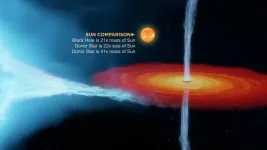INFORMATION:
Fuel for earliest life forms: Organic molecules found in 3.5 billion-year-old rocks
2021-02-18
(Press-News.org) A research team including the geobiologist Dr. Helge Missbach from the University of Cologne has detected organic molecules and gases trapped in 3.5 billion-year-old rocks. A widely accepted hypothesis says that the earliest life forms used small organic molecules as building materials and energy sources. However, the existence of such components in early habitats on Earth was as yet unproven. The current study, published in the journal 'Nature Communications', now shows that solutions from archaic hydrothermal vents contained essential components that formed a basis for the earliest life on our planet.
Specifically, the scientists examined about 3.5 billion-year-old barites from the Dresser Formation in Western Australia. The barite thus dates from a time when early life developed on Earth. 'In the field, the barites are directly associated with fossilized microbial mats, and they smell like rotten eggs when freshly scratched. Thus, we suspected that they contained organic material that might have served as nutrients for early microbial life,' said Dr. Helge Missbach of the Institute of Geology and Mineralogy and lead author of the study.
In the fluid inclusions, the team identified organic compounds such as acetic acid and methanethiol, in addition to gases such as carbon dioxide and hydrogen sulfide. These compounds may have been important substrates for metabolic processes of early microbial life. Furthermore, they are discussed as putative key agents in the origin of life on Earth. 'The immediate connection between primordial molecules emerging from the subsurface and the microbial organisms - 3.5 billion years ago - somehow surprised us. This finding contributes decisively to our understanding of the still unclear earliest evolutionary history of life on Earth,' Missbach concluded.
ELSE PRESS RELEASES FROM THIS DATE:
The mass of Cygnus X-1's black hole challenges stellar evolution models
2021-02-18
Weighing in at roughly 21 solar masses, the black hole in the X-ray binary system Cygnus X-1 is so massive that it challenges current stellar evolution models, a new study reveals. Ultimately, the mass of a black hole is determined by its parent star's properties and is generally constrained by the mass lost to stellar winds throughout its lifetime. If a black hole interacts with a binary companion star, the system emits X-rays and can sometimes form radio jets, which make the systems visible to electromagnetic observations as an X-ray binary. Measurements from known x-ray binaries have shown that black holes in these systems all have masses below 20 solar masses (M?), with the largest being 15-17 M?. However, gravitational wave detections of black hole merger events have found ...
Magnetic reversal 42,000 years ago triggered global environmental change
2021-02-18
Nearly 42,000 years ago, when Earth's magnetic fields reversed, this triggered major environmental changes, extinction events, and long-term changes in human behavior, a new study reports. The findings, made possible by a new radiocarbon record derived from New Zealand's ancient kauri trees, raise important questions about the evolutionary impacts of geomagnetic reversals and excursions throughout the deeper geological record, the authors say. "Before this work," says author Chris Turney in a related video, "we knew there were a lot of things happening around the world at 42,000 years ago, but we didn't know precisely how... For the first time, we've been able to precisely date what happened when Earth's magnetic fields last flipped." Written in the geological ...
More than half of Earth's rivers strongly impacted by human activity
2021-02-18
Few of Earth's freshwater areas remain untouched by humans. More than half of the planet's freshwater river basins have been heavily impacted by human activities, according to a new study, which presents a novel, multi-faceted approach for evaluating biodiversity change at a global scale. Although rivers and lakes cover less than 1% of the planet's surface, they support a substantial component of the planet's biodiversity, including a quarter of Earth's vertebrates. Further, freshwater systems support the functioning and stability of a variety of ecosystems, including those that contribute to human wellbeing. Centuries of human activity - overfishing, non-native species introductions, on-river development, ...
Lab-grown 'mini-bile ducts' used to repair human livers in regenerative medicine first
2021-02-18
Scientists have used a technique to grow bile duct organoids - often referred to as 'mini-organs' - in the lab and shown that these can be used to repair damaged human livers. This is the first time that the technique has been used on human organs.
The research paves the way for cell therapies to treat liver disease - in other words, growing 'mini-bile ducts' in the lab as replacement parts that can be used to restore a patient's own liver to health - or to repair damaged organ donor livers, so that they can still be used for transplantation.
Bile ducts act as the liver's waste disposal system, and malfunctioning bile ducts are behind a third of adult and 70 per cent of children's liver transplantations, with no ...
Organoids grown from bile duct cells repair human livers; may aid liver transplant processes
2021-02-18
Organoids grown from bile duct epithelial cells can be used to repair damaged bile ducts in transplanted human livers, researchers report. The results provide proof of concept for using ex vivo cell-based therapy to improve organ function before transplantation, which could ultimately increase the number of useable organs on the transplant waiting list. Bile produced in the liver is carried to the small intestine through a network of bile ducts formed by biliary epithelial cells known as cholangiocytes. While crucial for digestion, bile becomes toxic when it accumulates in the liver. As a result, chronic liver diseases that affect cholangiocytes often result in liver failure ...
Metabolic mutations help bacteria resist drug treatment
2021-02-18
CAMBRIDGE, MA -- Bacteria have many ways to evade the antibiotics that we use against them. Each year, at least 2.8 million people in the United States develop an antibiotic-resistant infection, and more than 35,000 people die from such infections, according to the U.S. Centers for Disease Control.
Most of the mutations known to confer resistance occur in the genes targeted by a particular antibiotic. Other resistance mutations allow bacteria to break down antibiotics or pump them out through their cell membranes.
MIT researchers have now identified another class of mutations that helps bacteria develop resistance. In a study of E. coli, they discovered that mutations to genes involved ...
Ancient relic points to a turning point in Earth's history 42,000 years ago
2021-02-18
The temporary breakdown of Earth's magnetic field 42,000 years ago sparked major climate shifts that led to global environmental change and mass extinctions, a new international study co-led by UNSW Sydney and the South Australian Museum shows.
This dramatic turning point in Earth's history - laced with electrical storms, widespread auroras, and cosmic radiation - was triggered by the reversal of Earth's magnetic poles and changing solar winds.
The researchers dubbed this danger period the 'Adams Transitional Geomagnetic Event', or 'Adams Event' for short - a tribute to science fiction writer Douglas Adams, who wrote in The Hitchhiker's Guide to the Galaxy that '42' was the answer to life, the universe, and everything.
The findings are published today ...
Ultrafast electron dynamics in space and time
2021-02-18
"For decades, chemistry has been governed by two ambitions goals," says Professor Stefan Tautz, head of the Quantum Nanoscience subinstitute at END ...
First black hole ever detected is more massive than we thought
2021-02-18
Cygnus X-1, a binary star system first discovered in 1964, comprises one of the closest black holes to Earth. New observations of this black hole, the first ever detected, have led astronomers to question what they know about the Universe's most mysterious objects.
An international team, including researchers from the National Astronomical Observatories of the Chinese Academy of Sciences (NAOC), recently found that the stellar-mass black hole in the Cygnus X-1 binary system has a mass 21 times the mass of the Sun and rotates at a speed close to the speed of light.
The study was published in Science on Feb. 18.
The researchers used the Very Long Baseline Array - a continent-sized radio ...
Engineers place molecule-scale devices in precise orientation
2021-02-18
Engineers have developed a technique that allows them to precisely place microscopic devices formed from folded DNA molecules in not only a specific location but also in a specific orientation.
As a proof-of-concept, they arranged more than 3,000 glowing moon-shaped nanoscale molecular devices into a flower-shaped instrument for indicating the polarization of light. Each of 12 petals pointed in a different direction around the center of the flower, and within in each petal about 250 moons were aligned to the direction of the petal. Because each moon only glows when struck by polarized light matching its orientation, the end result is a flower whose petals light up in sequence as the polarization of light shined upon it is rotated. The flower, which ...



